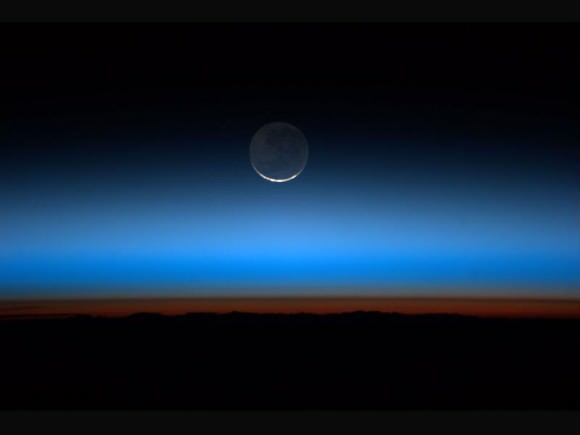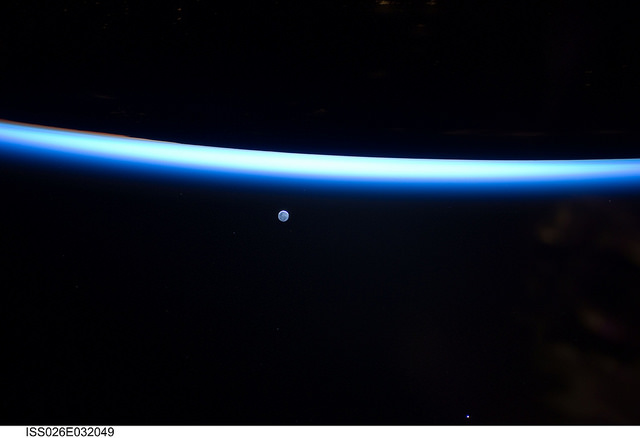[/caption]
Ah, the Moon! Earth’s constant companion and the subject of songs, poetry, and many an astrophoto here on Universe Today. But we always gaze upon the Moon under the cover of Earth’s atmosphere. Does it look any different from up above the world so high? Astronauts from the ISS have taken plenty of pictures of the Moon, and here are a couple recent and notable lunar images. The one above is of a crescent Moon taken in March of this year (2011) — notice the bright crescent sliver present even while the entire moon is visible. Here, the Moon looks teeny tiny. Below is another view of a bigger, but still crescent Moon as seen from the ISS.

Expedition 28 astronaut Ron Garan took this image just a few days ago on July 31, 2011 from the International Space Station. This is such a stunning image, it was featured on NASA’s Image of the Day Gallery. Garan noted the view saying, “We had simultaneous sunsets and moonsets.” For anyone in orbit, this extraordinary event is a daily occurrence. Since the station orbits the Earth every 90 minutes, each day the crew experiences such a view about 16 times a day.
See more from Ron Garan on his Twitpic page.


I dig it.
just wondering what the grey dot is bottom right is on the first picture??
Very likely a bright star like Vega, possibly Jupiter or even a ‘hot pixel’ (most digital cameras have a few of those, which are defective pixels on the sensor.) Without knowing the exact time and orbital position of the ISS when the picture was taken, rather tricky to be 100% certain.
If you look at the original image here:
http://spaceflight.nasa.gov/gallery/images/station/crew-26/hires/iss026e032049.jpg
you can see more stars.
I dig it.
loneliness and beauty
Amazing to consider that only a hand full of humans, out of all the billions who have ever lived, have ever witnessed such spectacular, star-canopied planetscapes above the clouds of human existence–in the full dynamic dimension of real time! Visions of celestial night over our sunlit, rapidly turning world ( from ISS perspective ). And how marvelous for us that that relatively large, silvery-gray Moon of Earth-embracing orbital dance, stabilizes our homeworld from the processional extremes that would otherwise, over spans of revolutionary time, be far less welcoming to the complex, robust, and delicate surface-weave of its life-teeming biosphere, that so thrives on this terrestrial water-planet of lunar embrace.
Amazing to consider that only a hand full of humans, out of all the billions who have ever lived, have ever witnessed such spectacular, star-canopied planetscapes above the clouds of human existence–in the full dynamic dimension of real time! Visions of celestial night over our sunlit, rapidly turning world ( from ISS perspective ). And how marvelous for us that that relatively large, silvery-gray Moon of Earth-embracing orbital dance, stabilizes our homeworld from the processional extremes that would otherwise, over spans of revolutionary time, be far less welcoming to the complex, robust, and delicate surface-weave of its life-teeming biosphere, that so thrives on this terrestrial water-planet of lunar embrace.